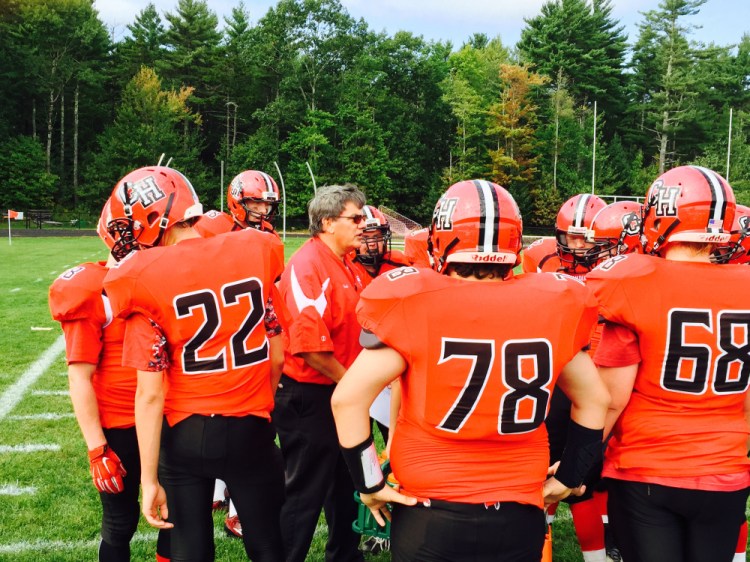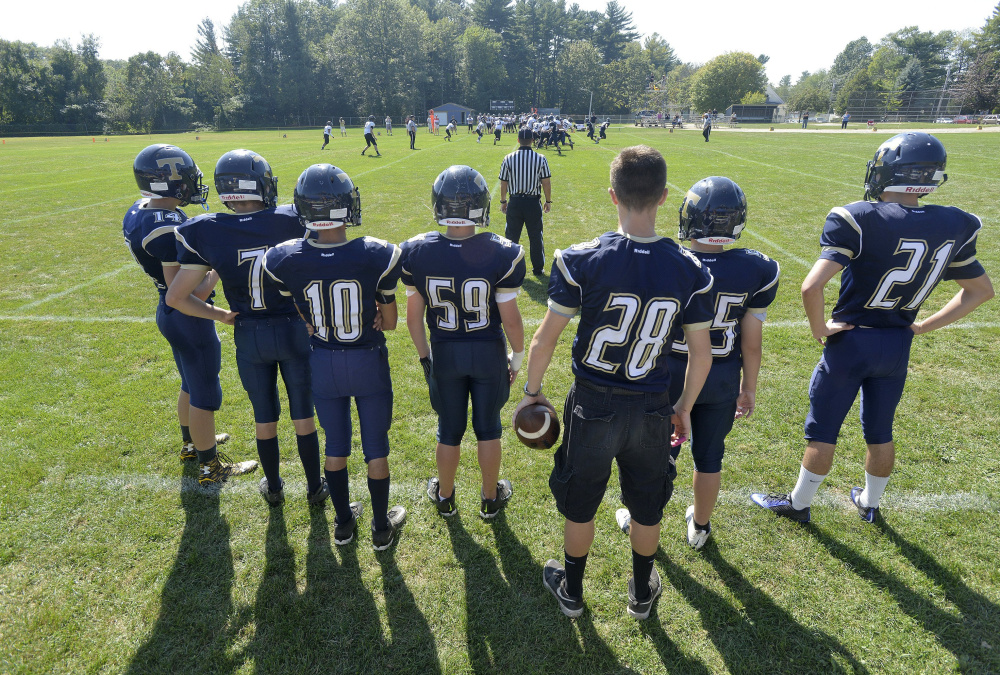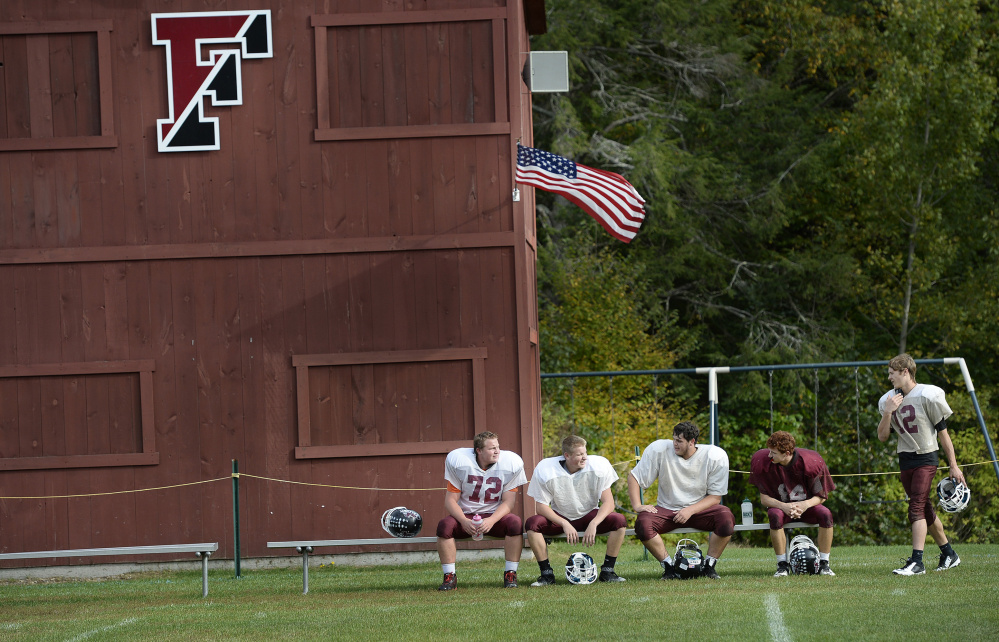The beginning of the end of varsity football at Camden Hills Regional High came during a Saturday afternoon game on Sept. 19. Head coach Thad Chilton turned around and saw a handful of starting players sitting on the bench, ice packs applied to wrists, knees and one neck.
“My linemen were dropping like flies,” Chilton said. “The attrition rate was killing us. And I have these young players next to me, standing alongside the girls. I can’t get them hurt.”
The Windjammers began the game with 23 players, 12 of them freshmen. Three players were girls – who played only on the kickoff teams – and others were so inexperienced Chilton used them sparingly.
Eight players were injured during the game, four of whom did not return. After the game, a 53-14 loss to Bucksport, Camden Hills athletic director Steve Alex was concerned.
“At some point the safety card might be played,” Alex said. It was and, five days later, the school announced that it was canceling the remainder of the season.
“Dwindling numbers of players have created a serious safety issue,” principal Nick Ithomitis said in the news release, “and we are simply not willing to put any more students at risk.”
The situation at Camden Hills is not unique. Sacopee Valley in Hiram forfeited its final game in 2013 after the football squad was down to 13 players. They have played as a junior varsity program since.
Several other varsity football teams in Maine are competing with fewer than two dozen players. In many cases, the teams struggle to be competitive on the field.
The problem has some high school administrators concerned about the viability of maintaining football, especially in communities with waning participation on youth teams that serve as feeders to the varsity programs. Some coaches cite athletes who fear risk of injury by playing the sport.
Overall, high school football participation in Maine declined 14 percent from 2006 to 2014, according to data from the Maine Principals’ Association. That compares with an 8.3 percent decline in the state’s high school enrollment over the same period. Nationally, participation in high school football has declined by 2.4 percent over the past five years, according to the National Federation of State High School Associations.
“I know a lot of towns that are struggling,” said Freeport High head coach Paul St. Pierre, whose team is slowly growing in numbers.
“We’ve jumped from 19 to 26,” he said.
The Maine Principals’ Association has no rule on roster size.
“There is nothing in terms of hard and fast numbers,” said Mike Burnham, an assistant executive director with the MPA. “We recommend a good number to field a team is at least 25. If the numbers get below 20, there is concern.”
Traip Academy in Kittery and Telstar High School in Bethel each has 17 players on its roster. Stearns High in Millinocket has 20.
The NFSHSA also has no roster-size regulation, except for players involved in play.
“Our rule reads that each team begins the game with 11 players,” said Bob Colgate, the group’s director of sports and sports medicine.
But the makeup of those 11 players is crucial.
“If the majority of the team is freshmen, we’re not going to put them out there,” said Telstar athletic director Gail Wight. Her small team contains six seniors and two juniors.
Conversely, a roster of 20 does not mean a team can safely compete.
“Just because a kid has a uniform on their back doesn’t mean they’re ready to play varsity football,” said Camden Hills’ Alex.
COMPETITION FROM OTHER SPORTS
Camden Hills’ enrollment of 669 students places it among Maine’s Class B schools. But the MPA granted permission for the Windjammers to play a Class C football school schedule the past two years. This year they played a Class D schedule – with the state’s smallest schools.
Camden Hills offers several fall sports for boys, led by its marquee soccer program (60 players), along with cross country (30), mountain biking (17), golf (14) and sailing (five).
“It’s crazy,” said senior football player Taylor Crosby. “It’s been very hard (to create excitement for football).”
The Camden Hills football team struggled after entering varsity play in 2009, compiling a 6-45 record. The losses made it difficult to attract players.
“We had 12 graduate last year and another 12 who did not come back out for the team,” said Chilton, who was in his first year as Camden Hills’ head coach after serving as one of the founders of the area youth football league.
“People have just fled the program.”
Because of its forfeiture, MPA rules state that Camden Hills cannot have a varsity program the next two years – a ruling which can be appealed.
The school could field a junior varsity team the next two years, or go back to being a club sport or scrap the program. An open forum is being held at the school Monday to discuss the program’s future.
Other so-called “soccer schools” have succeeded in incorporating football, including Yarmouth, Falmouth and Cape Elizabeth. Cape began in 2003 and Aaron Filieo became head coach the next year.
“I did hear this was a soccer town and (football) would never fly,” Filieo said. “I believe there were a lot of kids walking around the halls who had no interest in playing soccer, and wanted another competitive sport to play.”
Cape Elizabeth, a Class C school, has 47 football players.
Even with the success the Cape football program has had under Filieo, he said it can be difficult at times to persuade students to come out for the team – because of fear of injury.
“The biggest reason I hear from kids for not playing is ‘I’m not big enough,'” said Filieo. “This is Maine Class C football. Some of the best players in the league are between 150 and 170 pounds.”
Steve LaPointe, the coach at Mountain Valley High in Rumford, said his expected starting quarterback did not go out for football this year because of a previous concussion. He joined the soccer team instead.
‘WE DON’T HAVE A FEEDER SYSTEM’
Traip Academy has been holding on with a football roster that has “always hovered just under or over 20, for the last 10 or 12 years,” said athletic director Mike Roberge.
The Rangers, who once lost 51 straight games – the streak ending in 2006 – and then reached the Western D title game in 2011, are 1-3 this year.
“It’s amazing we have gone on for as long as we have,” head coach Ron Ross said.
But the future is in jeopardy. There is no youth league feeding into the program. Traip’s current roster of eligible players includes two seniors, eight juniors, four sophomores and three freshmen.
Roberge is concerned about what happens when those juniors graduate.
“I wouldn’t be telling you the truth if I say I’m not worried about losing those kids – if we don’t have a feeder system in place,” Roberge said.
“If we don’t get that (youth) program back and flourishing, it could have a dramatic effect on our program.”
Roberge said he and Ross are working with the Kittery Recreation Department to bring back youth football. Ross has offered to coach the team.
Meanwhile, Ross is trying to develop a team that is challenged to conduct a full scrimmage in practice.
“Coaches fill in, in spots. I’m the scout-team quarterback,” Ross said. “It’s tough. But we keep plugging away.”
With so few players for a game, so many have to play both ways and, “of course, they get worn down,” Ross said.
At Telstar, the Rebels also wear down. They have lost all four games this season by a combined score of 173-0. Last year, Telstar qualified for the playoffs because of a forfeit win over Traip (Traip won 40-6, but used an ineligible player). The Rebels turned down the postseason bid because of safety concerns.
There is youth football in Bethel, but Telstar coach Lew Brann said there are “not many” in the eighth grade. That could be trouble since six of the current 17 Telstar players are seniors.
“It’s a big challenge this year and will be next year,” Brann said. He added that the youth leagues have better numbers below eighth grade so “it’s going to take a couple of years.”
Stearns, with its 20 players, has been surviving with low numbers for years. Millinocket is a shrinking town since its paper mill closed and Stearns is the smallest football-playing school in the state with 181 students.
“Numbers are always going to be a concern,” said athletic director Fred Lazo.
SACOPEE VALLEY REBUILDS
When Sacopee Valley High forfeited its final game in 2013, there were fears that would be the end of football at the school. Five years as a varsity program had produced a 0-40 record. The Hawks went strictly to junior varsity in 2014 and finished with only 15 players. And Sacopee Valley has lost enrollment, down 20 percent over the last nine years, to 401 students.
“We’re a very rural area (in southwest Oxford Country). We draw from five towns and kids drive from all over to get here,” said athletic director Chris Hughes. “It’s a big commitment to be part of a sports program.”
The Hawks hired a new coach this year, asking assistant principal Jim Walsh to take over the program. Walsh, a former head coach at Old Town, hired a staff of mostly coaches that are already on campus. Together, they began recruiting.
“We doubled the number of kids,” Walsh said. Even with 10 of the 30 players being seniors, Walsh said the program could grow to 35 or more players next year.
“Then we’ll have a very big decision to make,” Walsh said. “Either continue as a junior varsity team or move on to the varsity level.”
Sacopee Valley is enjoying success this year with a 4-0 junior varsity record. Walsh is cautious.
“People say, ‘Geez, you’re scoring 30 points a game, so you’re ready for varsity,” Walsh said. “But we have to continue to build up our numbers and get kids in the weight room.”
At Freeport, the numbers are trending up. New coach St. Pierre has also worked his way up, from the youth leagues, to the middle school, to being an assistant varsity coach last year.
While Freeport was 0-5 after Saturday’s game, losing by a combined score of 238-37, both St. Pierre and athletic director Craig Sickels say the scoreboard can be deceiving.
“We’ve been able to compete physically,” Sickels said. “We’re getting out-executed.”
Inexperience and depth are a problem, but St. Pierre is optimistic.
“I know the town well and in our lower ranks – in the youth leagues and middle school teams – we have really high numbers,” he said. “The biggest reason I wanted this job is because I know what the future holds.”
St. Pierre said there are 25 players in the seventh and eighth grades, and 40 in grades four through six.
Adding more players pleases Sickels. Shrinking rosters carry risks.
“I don’t think there is a magic number for a roster but, for example, if you lose your two starting guards, then your quarterback might get injured,” Sickels said. “Safety is first and foremost.”
One option that other states use for smaller schools is a league for eight-player teams. According to the NFSHSA, 20 states have such leagues, although none in New England (Vermont dropped it in 2005).
Eight-man football subtracts two linemen and one skill player on offense, and usually two linemen and a linebacker or secondary player on defense. In 2010, the MPA surveyed schools in Maine to determine the interest in eight-man football.
Burnham said the results showed “very little support to move in that direction.”
Maine high schools want traditional 11-man football. But a team needs much more than 11 players to compete in a season, and its needs players ready for varsity competition.
That is a challenge for some schools and, as Camden Hills recently discovered, a challenge not all can meet.
Kevin Thomas can be contacted at 791-6411 or at:
kthomas@pressherald.com
Twitter: KevinThomasPPH
Corrected: This story was updated at 4:35 p.m. on Oct. 5, 2015, to correct the spelling of the Telstar athletic director’s name.
Send questions/comments to the editors.






Success. Please wait for the page to reload. If the page does not reload within 5 seconds, please refresh the page.
Enter your email and password to access comments.
Hi, to comment on stories you must . This profile is in addition to your subscription and website login.
Already have a commenting profile? .
Invalid username/password.
Please check your email to confirm and complete your registration.
Only subscribers are eligible to post comments. Please subscribe or login first for digital access. Here’s why.
Use the form below to reset your password. When you've submitted your account email, we will send an email with a reset code.